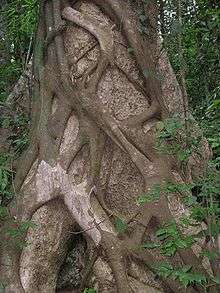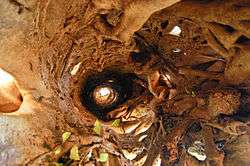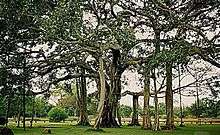Banyan
| Banyan (also banian) | |
|---|---|
 | |
| Banyan with characteristic adventitious prop roots | |
| Scientific classification | |
| Kingdom: | Plantae |
| (unranked): | Angiosperms |
| (unranked): | Eudicots |
| (unranked): | Rosids |
| Order: | Rosales |
| Family: | Moraceae |
| Genus: | Ficus |
| Subgenus: | Urostigma |
| Species | |
|
Many species, including: | |
A banyan (also banian[1]) is a fig that starts its life as an epiphyte (a plant growing on another plant) when its seeds germinate in the cracks and crevices on a host tree or on buildings and bridges. Banyan often refers specifically to the Indian banyan (Ficus benghalensis), which is the national tree of the Republic of India,[2] though the term has been generalized to include all figs that share a characteristic life cycle, and systematically to refer to the subgenus Urostigma.[3]
Like other fig species (including the common edible fig Ficus carica), banyans bear multiple fruit in structures called syncarps. The Ficus syncarp supplies shelter and food for fig wasps and in turn, the trees are totally dependent on the fig wasps for pollination.
The seeds of banyans are dispersed by fruit-eating birds. The seeds are small, and most banyans grow in forests, so a plant germinating from a seed that lands on the ground is unlikely to survive. However, many seeds land on branches and stems of trees or on buildings. When those seeds germinate, they send roots down towards the ground, and may envelop part of the host tree or building structure, giving banyans the casual name of "strangler fig". The "strangling" growth habit is found in a number of tropical forest species, particularly of the genus Ficus, that compete for light.[4][5][6] Any Ficus species showing this habit may be termed a strangler fig.
The leaves of the banyan tree are large, leathery, glossy green, and elliptical in shape. Like most fig trees, the leaf bud is covered by two large scales. As the leaf develops, the scales fall. Young leaves have an attractive reddish tinge.[7]
Older banyan trees are characterized by their aerial prop roots that grow into thick woody trunks, which can become indistinguishable from the main trunk with age. Old trees can spread out laterally, using these prop roots to cover a wide area. In some species, the effect is for the props to develop into a sort of forest covering a considerable area, every trunk connected directly or indirectly to the central trunk. The topology of this structure of interconnection inspired the name of the hierarchical computer network operating system Banyan VINES.
In a banyan that envelops a support tree, the mesh of roots growing around the support tree eventually applies very considerable pressure and commonly kills the tree. Such an enveloped, dead tree eventually rots away, so the banyan becomes a "columnar tree" with a hollow central core. In jungles, such hollows are particularly desirable shelters to many animals.
Etymology
The name was originally given to F. benghalensis and comes from India, where early travellers observed that the shade of the tree was frequented by banias or Indian traders.[8]
In the Gujarati language, banya means "grocer or merchant", not "tree". The Portuguese picked up the word to refer specifically to Hindu merchants, and passed it along to the English as early as 1599 with the same meaning. By 1634, English writers began to tell of the banyan tree, a tree under which Hindu merchants conducted their business. The tree provided a shaded place for a village meeting or for merchants to sell their goods. Eventually, "banyan" became the name of the tree itself.
Classification
The original banyan, F. benghalensis, can grow into a giant tree covering several hectares. Over time, the name became generalized to all strangler figs of the Urostigma subgenus. The many banyan species include:
- Ficus microcarpa, which is native from Sri Lanka through New Caledonia, is a significant invasive species elsewhere.
- The Central American banyan (Ficus pertusa) is native to Central America and northern South America, from southern Mexico south to Paraguay.
- The shortleaf fig (Ficus citrifolia) is native to southern Florida, the Caribbean Islands, Central America, and South America south to Paraguay. One theory is that the Portuguese name for F. citrofolia, os barbados, gave Barbados its name.
- The Florida strangler fig (Ficus aurea) is also native to southern Florida and the Caribbean Islands, and distinguished from the above by its coarser leaf venation.
- The Moreton Bay fig (Ficus macrophylla) and Port Jackson fig (Ficus rubiginosa) are other related species.
Ornamental value


Due to the complex structure of the roots and extensive branching, the banyan is extensively used for creating bonsai. Taiwan's oldest living bonsai is a 240-year-old banyan housed in Tainan.[9]
In culture
Religion and mythology
Banyan trees figure prominently in several Asian and Pacific religions and myths, including:
- The banyan tree is the national tree of India. It is also called Indian or Bengal fig. This tree is considered sacred in India and can be seen near a temple or religious center. It is a big tree and gives shade to travelers in very hot summer months. An old custom offers worship to this tree.
- In Hinduism, the leaf of the banyan tree is said to be the resting place for the god Krishna.
- In the Bhagavat Gita, Krishna said, "There is a banyan tree which has its roots upward and its branches down, and the Vedic hymns are its leaves. One who knows this tree is the knower of the Vedas." (Bg 15.1) Here the material world is described as a tree whose roots are upwards and branches are below. We have experience of a tree whose roots are upward: if one stands on the bank of a river or any reservoir of water, he can see that the trees reflected in the water are upside down. The branches go downward and the roots upward. Similarly, this material world is a reflection of the spiritual world. The material world is but a shadow of reality. In the shadow there is no reality or substantiality, but from the shadow we can understand that there is substance and reality.
- The banyan tree is also considered sacred and is called vat vriksha (IAST vaṭa vṛkṣa, वट वृक्ष) in Sanskrit, in Telugu known as: మర్రి చెట్టు; marri chettu, and in Tamil known as: 'ஆல மரம்' ; ala maram. The god Shiva as Dakshinamurthy is nearly always depicted sitting in silence under the banyan with rishis at his feet. It is thought of as perfectly symbolizing eternal life due to its seemingly unending expansion.
- In spoken Marathi, the tree is known as vad (वड), derived from the original Sanksrit word vaṭa for the tree. Married Marathi women observe a fast called Vat Savitri Vrat for the well-being and long life of their husband.Tying a thread around the banyan or vat tree is an important part of the ritual.[10]
- In modern parlance in the Hindi language, it is known as bargad, vatavriksh, and barh.
- In Buddhism's Pali canon, the banyan (Pali: nigrodha)[11] is referenced numerous times.[12] Typical metaphors allude to the banyan's epiphytic nature, likening the banyan's supplanting of a host tree as comparable to the way sensual desire (kāma) overcomes humans.[13]
- The Lam Tsuen Wishing Trees (林村許願樹) are banyan, and are a popular shrine in Hong Kong. They are located near the Tin Hau Temple in Lam Tsuen.
- In many stories of Philippine mythology, the banyan (locally known as balete or balite) is said to be home to a variety of spirits (diwata and engkanto) and demon-like creatures (among the Visayans, specifically, the dili ingon nato, meaning "those not like us"). Maligno (evil spirits, from Spanish for 'malign') associated with it include the kapre (a giant), duwende (dwarves), and the tikbalang (a creature whose top half is a horse and whose bottom half is human).[14] Children at a young age are taught never to point at a fully mature banyan tree for fear of offending the spirits that dwell within them, most especially when they are new to the place. Filipinos always uttered a respectful word or two to the spirits in the banyan tree when they are near one, walking near or around it to avoid any harm. Nearly every Filipino believes that provoking the spirits in a banyan tree can cause one great harm, illness, misfortune, untold suffering, and death.
- In Guam, the Chamorro people believe in tales of taotaomona, duendes, and other spirits. Taotaomona are spirits of the ancient Chamorro that act as guardians to banyan trees.[15]
Locations

- Thimmamma Marrimanu is the name of a banyan tree in Anantapur district, located about 35 km from town Kadiri in the state of Andhra Pradesh, India. It is present in the Indian Botanical Gardens and is more than 200 years old. It is reported to be the world's biggest tree with a canopy of 19,107 m2. Its branches spreads over 8 acres, hence it was recorded as the biggest tree in the Guinness Book of World Records in 1989.
- One of the largest trees, named the Great Banyan, is found in Kolkata in India. It is said to be more than 250 years old. Another such tree, named Doda Alada Mara, is found in the outskirts of Bangalore. Doda Alada Mara has a spread around 2.5 acres.[16]
- One of the most famous of banyan trees was planted on the island of Kabirvad in Gujarat. Records show that the Kabirvad tree is more than 300 years old.
- Maui, Hawaii has a banyan tree planted by William Owen Smith in 1873 in Lahaina's Courthouse Square. It has grown to cover two-thirds of an acre.[16]
- In rural parts of India, many villages and towns have a traffic circle and a community gathering place around a big old banyan tree. At night, many people come to sit, relax, and chat around it. Usually, a small deity is placed and worshipped at its foot.
- Ta Prohm in the Angkor Wat temple complex of Cambodia is well known for the giant banyans that grow up, around, and through its walls.
- Several banyans can be found near downtown Hilo, Hawaii. Some of them were planted by celebrities throughout the 20th century and form Banyan Drive.
- Banyans also occur in areas of Australia such as the Daintree rainforest in Queensland's far north. Well known is the Curtain Fig Tree on the Atherton Tablelands.
- The first banyan tree in the continental U.S. was planted by Thomas Alva Edison in Fort Myers, Florida, in an attempt with Henry Ford to find a more cost-effective way to produce rubber for car tires. The tree, originally only 4 feet (1.2 m) tall, now covers an acre of land on the estate.
- One large banyan tree called Kalpabata is inside the premises of Jagannath Temple of Puri. It is considered sacred by the devotees and is supposed to be more than 500 years old.[17]
- A large banyan tree lives in Cypress Gardens, at the Legoland theme park located in Winter Haven, Florida. It was planted in 1939 in a 5-gallon bucket.[18]
Other
- The banyan is part of the coat of arms of Indonesia. It is meant to symbolize the unity of Indonesia - one country with many far-flung roots. As a giant tree, it also symbolizes power. Soeharto used it as a logo for his party, the Golongan Karya (Golkar), taking advantage of the deeply rooted belief of his fellow-countrymen and women in the sacred (sakti) nature of the banyan.
- The Economist magazine features an opinion column covering topics pertaining to Asia named "Banyan".[19]
- In southern Vanuatu, the clearings under banyan trees are used as traditional meeting places. The quarterly newsletter of the British Friends of Vanuatu Society is named Nabanga, after the local word for banyan.[20]
- The Banyan Tree is the name of one of the most fiendishly difficult rooms in the 1984 ZX Spectrum game Jet Set Willy.[21]
See also
References
- ↑ banian. Dictionary.com. Dictionary.com Unabridged. Random House, Inc. http://www.dictionary.com/browse/banian (accessed: March 15, 2016).
- ↑ "National Tree". Government of India Official website. Retrieved 2012-01-16.
- ↑ Note usage of "Banyan" versus "banyan" in ""Trees with a Difference: The Strangler Figs"" (PDF). (61.0 KB) by Vidya R. Athreya, Nature Watch, July 1997; also "Aerial-rooting banyan trees", Archived September 4, 2007, at the Wayback Machine. washington.edu
- ↑ Zhekun, Zhou & Michael G. Gilbert (2003) Flora of China (Moraceae) 5: 21-73. Harvard.edu
- ↑ Serventy, V. 1984. Australian Native Plants. Victoria: Reed Books.
- ↑ Light in the rainforest 1992 Tropical topics. Vol 1 No. 5 QLD.gov.au
- ↑ The Lovely Plants
- ↑ Yule, Henry, Sir. Hobson-Jobson: A glossary of colloquial Anglo-Indian words and phrases, and of kindred terms, etymological, historical, geographical and discursive. New ed. edited by William Crooke, B.A. London: J. Murray, 1903.
- ↑ Taipei Times, "Small is the old big", September 22, 2005
- ↑ http://www.hindu-blog.com/2007/05/significance-of-vat-savitri-puja.html
- ↑ T.W. Rhys Davids & William Stede (1921-25), Pali-English Dictionary (Chipstead: Pali Text Society), p. 355, entry "Nigrodha," retrieved 22 November 2008 from University of Chicago.
- ↑ See, for instance, the automated search of the SLTP ed. of the Pali Canon for the root "nigrodh" which results in 243 matches "Search term 'Nigrodh' found in 243 pages in all documents". Bodhgayanews.net. Archived from the original on 2 December 2008. Retrieved 22 November 2008.
- ↑ See, e.g., SN 46.39, "Trees [Discourse]," trans. by Bhikkhu Bodhi (2000), Connected Discourses of the Buddha: A Translation of the Saṃyutta Nikāya (Boston: Wisdom Publications), pp. 1593, 1906 n. 81; and, Sn 2.5 v. 271 or 272 (Fausböll, 1881, p. 46).
- ↑ Balete Tree
- ↑ Guampdn.com, Ghost stories: Taotaomona, duendes and other spirits inhabit Guam
- 1 2 John R. K. Clark (2001). Hawai'i place names: shores, beaches, and surf sites. University of Hawaii Press. p. 23. ISBN 978-0-8248-2451-8.
- ↑
- ↑ LEGOLAND Florida The Belle of Theme Parks
- ↑ "In the shade of the banyan tree". The Economist. 8 April 2009.
- ↑ Home Page
- ↑ CRASH 4 - Jet Set Willy
External links
| Look up banyan in Wiktionary, the free dictionary. |
| Wikimedia Commons has media related to Banyans. |
- Stranglers and Banyans, palomar.edu
- Plant Cultures: Banyan tree history and botany, plantcultures.org.uk
